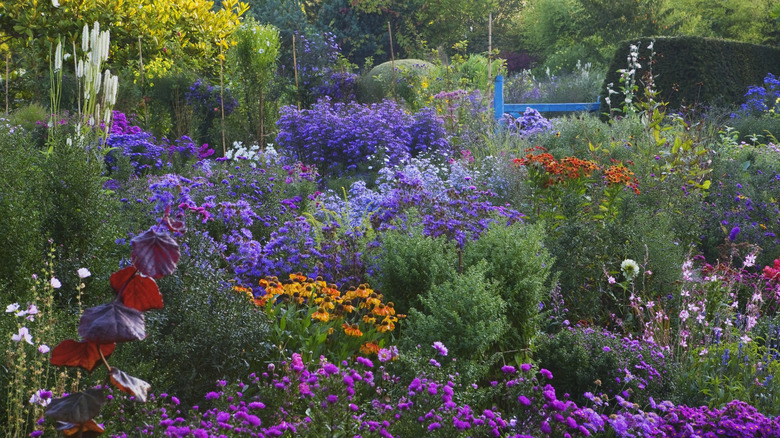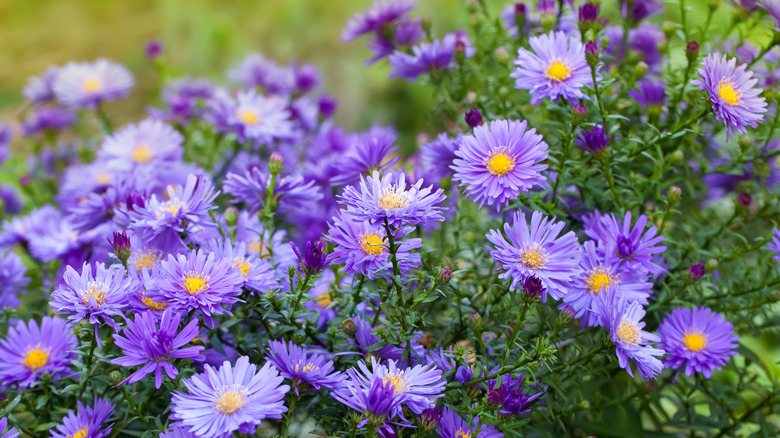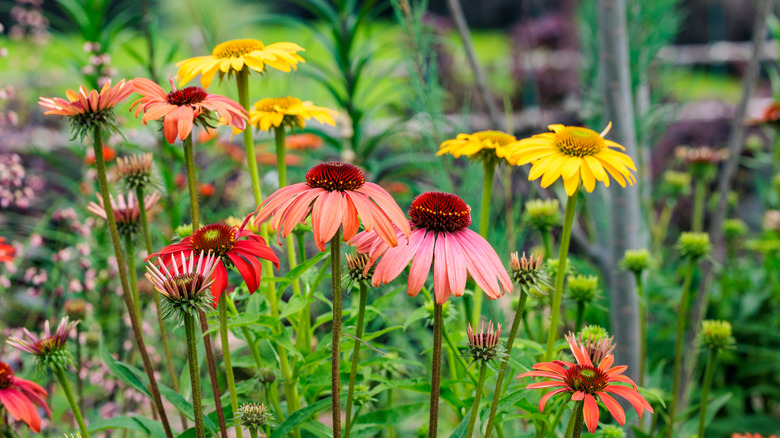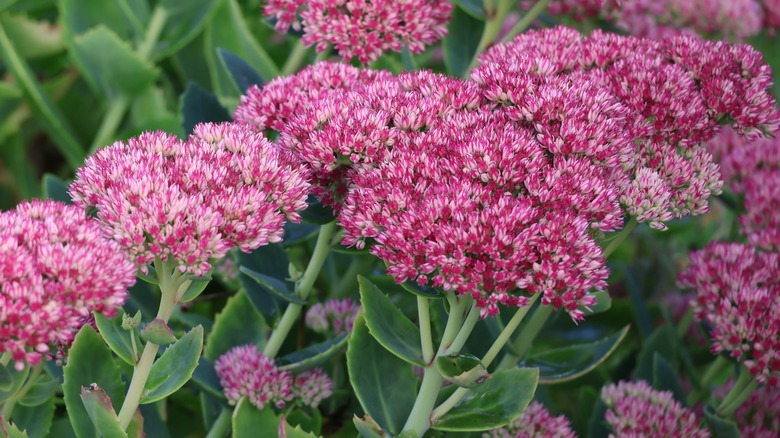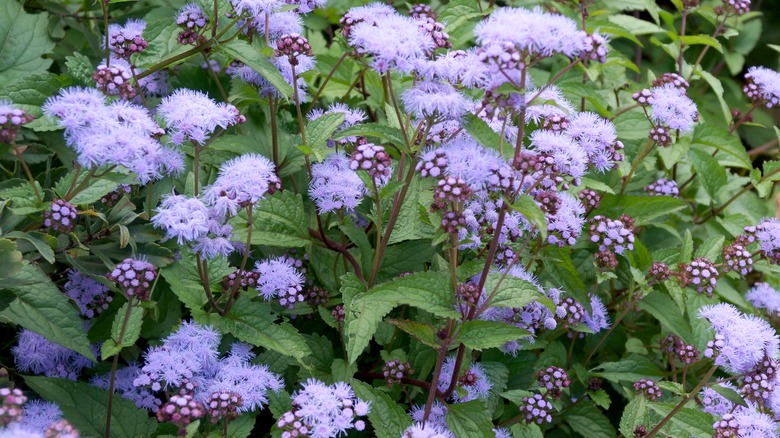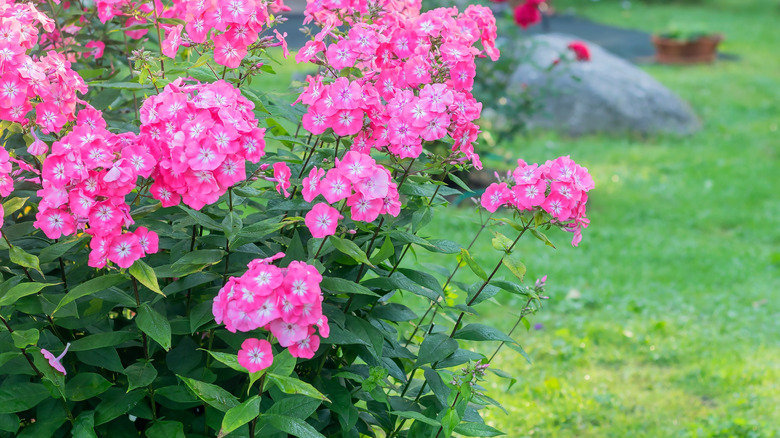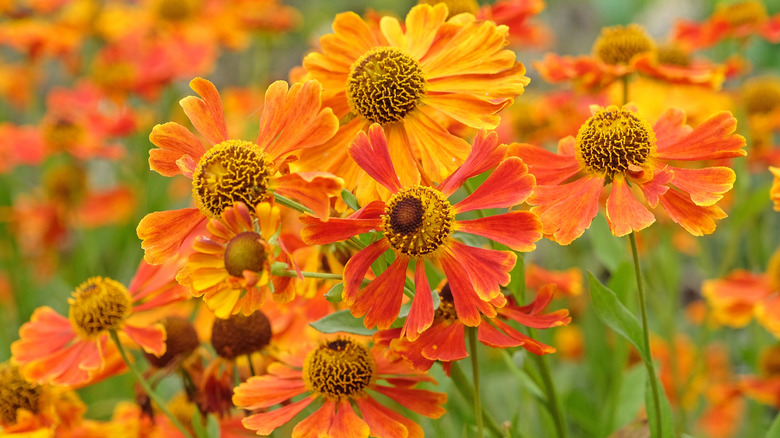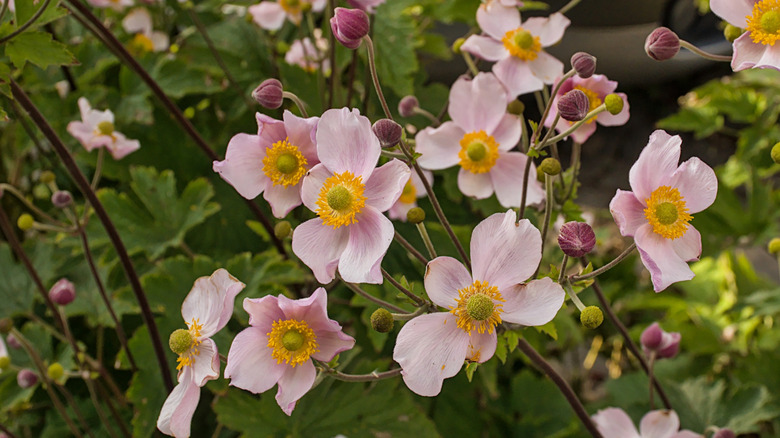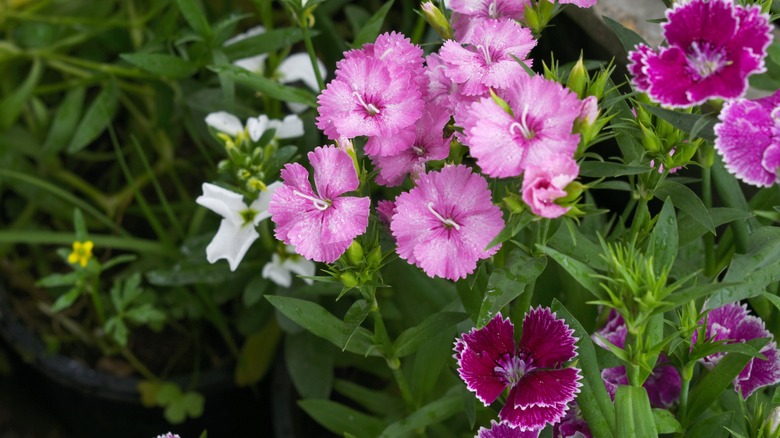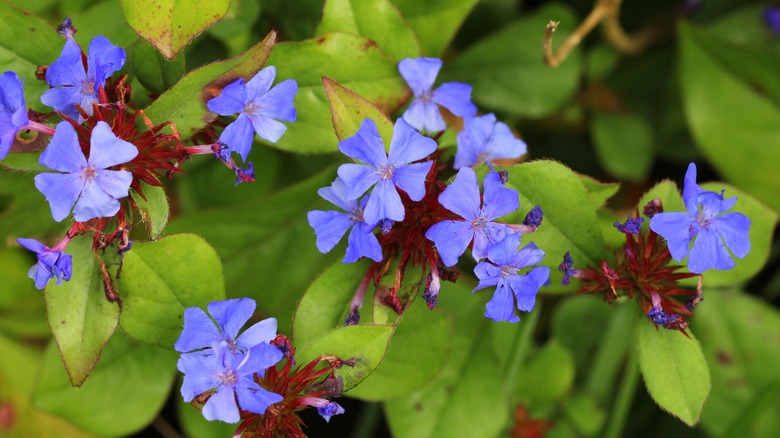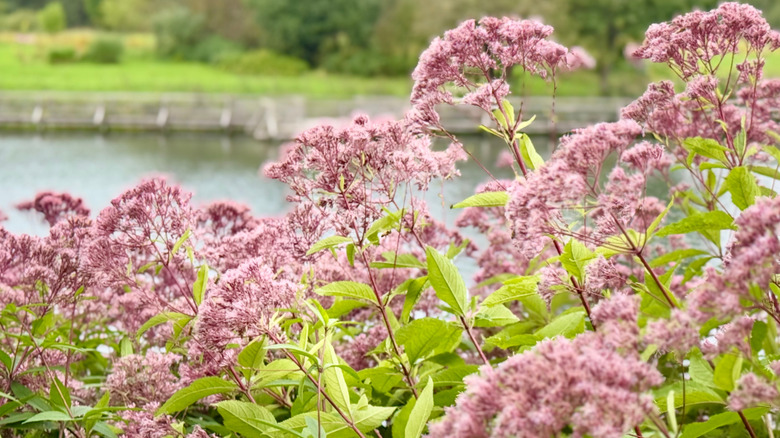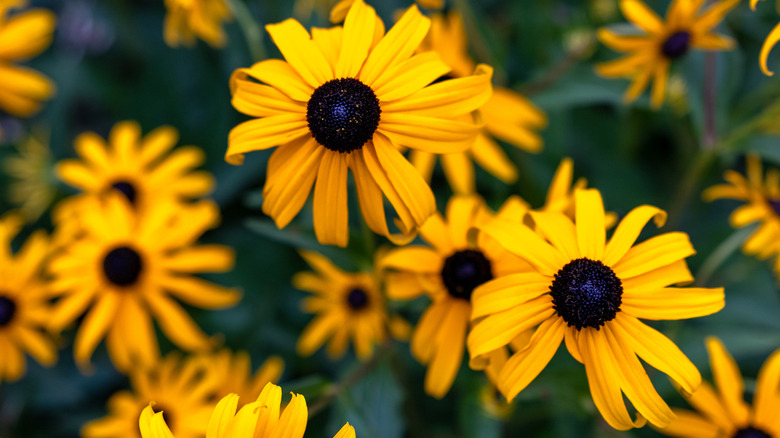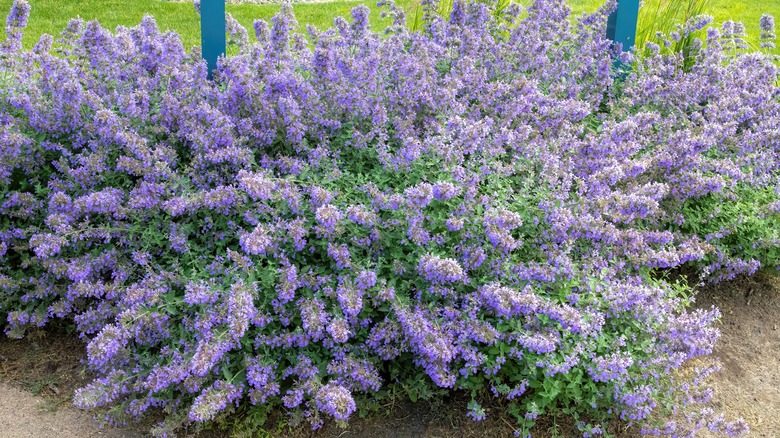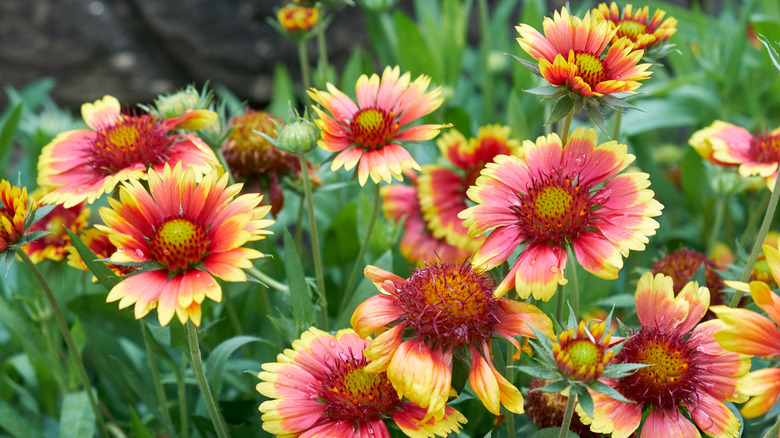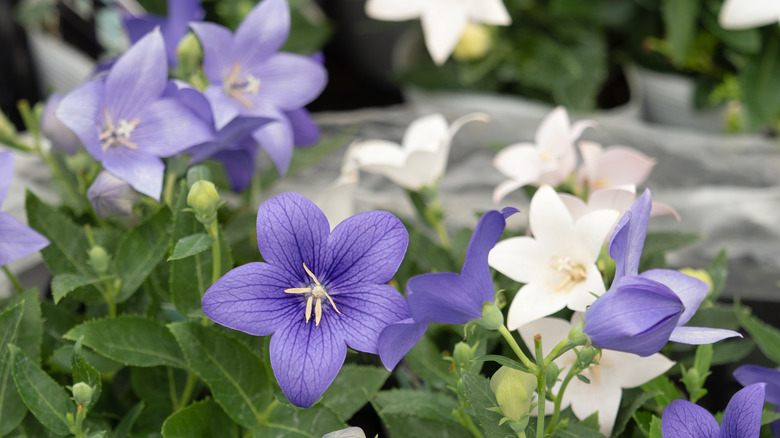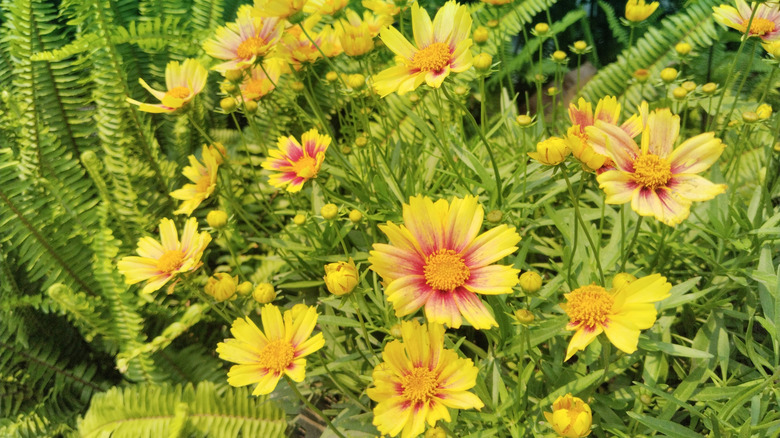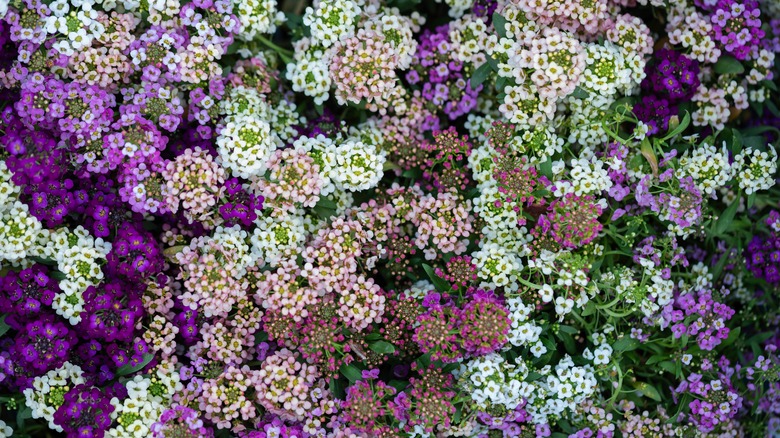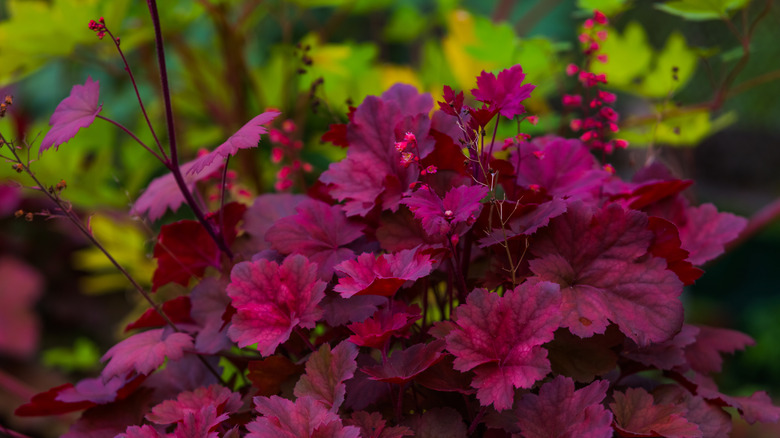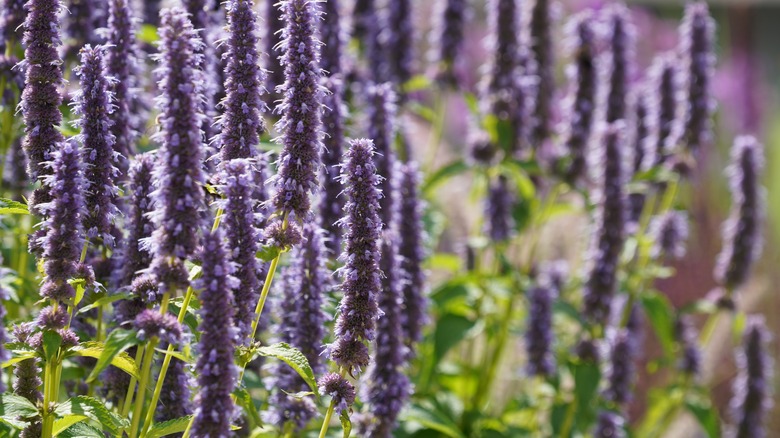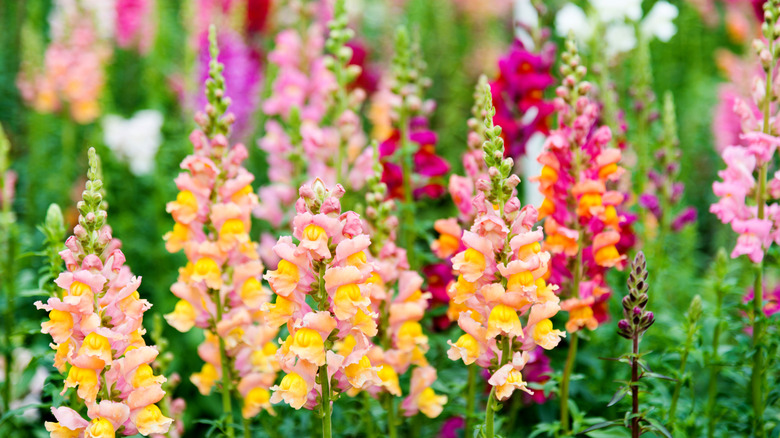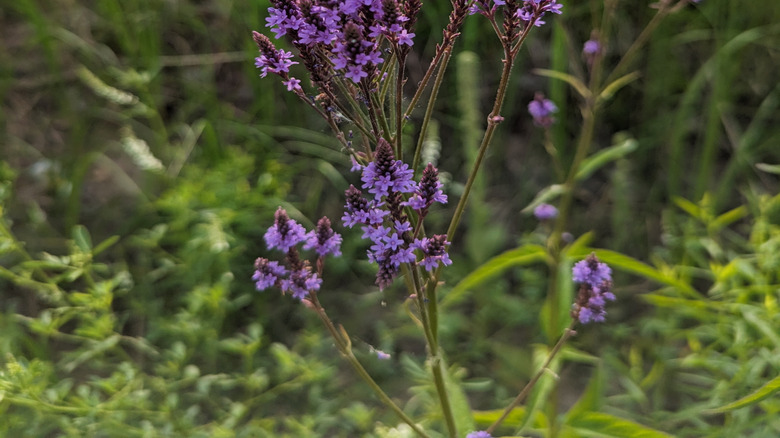Stunning Alternatives To Mums To Grow In Your Garden For Long-Lasting Color
Now, don't get me wrong, I absolutely love growing mums in the garden. As a professional gardener, I usually plant mums for multiple clients every year, in containers or in garden beds. Chrysanthemums are colorful, hardy, sturdy perennials that light up the autumn garden with long-lasting blooms. But there are plenty of alternatives to mums for your perennial garden that are easy to grow and also provide long-lasting color.
To truly compete with mums, the ubiquitous late-season flower, I chose perennials that are low maintenance and provide weeks of seasonal color. All of the perennials suggested here are cold-hardy, easy to care for, and require only some deadheading to keep them blooming through the autumn season. Some of them even keep blooming past the first hard frost, prolonging your garden season with beautiful colors.
Some of these perennials offer color choices that you can't get with mums: despite being available in a rainbow of colors, there aren't any mums in shades of blue or violet, so having some other options allows you greater design possibilities. I especially love blue and purple asters for late-season cool tones, as well as tall garden phlox, hardy plumbago, and blue mistflower. Some of these plants also offer heights, shapes, and textures that are very different from mums (like blue vervain, Japanese anemones, and Joe Pye weed) to help you create a vibrant and unforgettable autumn garden display.
Asters
Asters are a wonderful choice for gardeners who enjoy a cooler color palette. The range of purples, pinks, blues, and whites includes magenta and crimson, too. Most varieties have yellow centers, but there are some solids without centers, too. Try some tall ones in the back of the bed (like 'September Ruby' or 'Purple Dome') and shorter varieties (like 'Woods Blue' or 'Woods Pink') in front to fill the autumn border with vivid color for weeks. Deadhead the spent flowers to keep the new buds coming.
Coneflowers
Coneflowers (Echinacea) are sturdy perennials that bloom from late summer through autumn. The classic form is like a daisy with a prominent cone center, but there are also newer hybrids in pom-pom shapes without center cones. The color range includes many warm hues like pink, orange, yellow, and red, plus some greens and lavenders. They benefit from deadheading, but if you want birds to be able to eat the nutritious seeds, leave some of the seed cones intact as the season ends.
Sedums
These resilient perennials, also known as stonecrop, are drought-tolerant and thrive in partial shade to full sun. The upright varieties are the most showy, but the creeping varieties make nice ground covers or fillers for the front of beds. Sedums can be moved or divided at almost any time during the season. Divide them every two or three years to keep them at a healthy size. The stems can be cut back in midsummer to control their height if desired, and new buds will form. Try 'Autumn Joy,' 'Neon,' or 'Matrona' for reliable autumn color.
Blue mistflowers
Blue mistflower, also known as ageratum (Conoclinium coelestinum), is a delicate-looking but sturdy flower that blooms well in partial shade. The smaller annual version of these flowers is commonly chosen for summer containers, but these perennials start blooming in late summer and continue through the first days of frost. Available in periwinkle blue or creamy white, they spread assertively but not aggressively: the shallow root systems can be easily pulled up to control their spread.
Tall garden phlox
Tall garden phlox (Phlox paniculata) provides vivid color in the late summer and autumn garden. There's a wide range of colors and sizes available, from pastel pinks and whites to bold magentas, reds, and purples. The older heirloom varieties are lightly fragrant. In gardens where they've been established for a while, I've seen different phlox varieties hybridize together to make new color combinations. They like a bit of space around them for air circulation, which helps prevent powdery mildew from forming on the leaves.
Helenium
Known by the charming folk name "sneezewort," these tall daisy-like flowers glow with warm, sunny colors in the summer garden. Keep the spent flowers deadheaded, and they'll keep blooming into autumn. Helenium likes the sun and is not very fussy about soil. I like them in the back of the bed because they get fairly tall. They come in various combinations of red, orange, and yellow, with cute round button centers, and make nice cut flowers for arrangements.
Japanese anemones
Japanese anemones (Anemone japonica) have a dreamy quality in the garden, with their delicate blooms high atop long stems and large, grape-like dark green leaves. The most common variety, Anemone robustissima, is a pleasing pale pink. There are also various whites and rosy pinks (like 'Fantasy Jasmine' or 'Curtain Call Deep Rose') available. These late-season beauties bloom in partial shade and will reseed themselves happily in the garden.
Dianthus
Dianthus, also called "pinks" and "sweet William," comes in a few different forms, including the fragrant double flowers known as carnations. Dianthus barbatus is often sold as an annual, but I've had great luck growing it as a perennial. With frequent deadheading, these sprightly flowers will keep blooming all summer and well into autumn. I trim the foliage back frequently to keep it fresh and healthy.
Hardy plumbago
I'm always astonished that more people don't grow this gorgeous perennial, which is also known as leadwort. Hardy plumbago (Ceratostigma plumbaginoides) works well as a ground cover, or it's a good plant for tucking between other perennials in the border. It wakes up late and starts putting out light green glossy leaves in mid-summer. The bright blue flowers appear in September, with deep burgundy accents, making this a colorful option for the late-season flower bed.
Joe Pye weed
This pollinator magnet features gorgeous, pale mauve flowers that add an unusual hue to the summer garden. Joe Pye weed (Eutrochium purpureum) thrives in moist, loamy soil and prefers partial sun. There are smaller cultivars available now, but the classic native version of this plant can grow up to seven feet tall. The roots can get quite dense, making it harder to divide over time, so I find that dividing the plant clump every two or three years helps make this task more manageable.
Black-eyed Susan
This longtime favorite is a dependable summer bloomer. Keep the spent blooms deadheaded, and your black-eyed Susan (Rudbeckia) will keep forming new buds and blooms throughout the autumn season. Growing black-eyed Susan means keeping ahead of the plant's tendency to reseed aggressively in the garden, but there are other Rudbeckia that are less likely to spread, and there are other colors available too, like 'Cherokee Sunset' with deep burgundy petals or 'Prairie Sun' with golden petals with green centers.
Flowering catmint
Yes, it's attractive to cats, but not invasive like catnip! Flowering catmint (Nepeta) grows in tidy clumps and puts out stalks of tiny purple flowers full of fragrant nectar that attracts all kinds of pollinators, including hummingbirds. When the flower bracts start to fade in late summer, trim them back, and new buds will appear for a new round of bloom that continues through fall, giving late-season pollinators a tasty treat.
Blanket flowers
Blanket flower (Gaillardia) is a daisy-like flower that puts on a long show of flowers in summer and blooms well into autumn with deadheading. Some gardeners grow it as an annual, but if grown in a sunny spot with well-drained soil, most varieties will perennialize nicely. Two of the most popular cultivars are 'Arizona Sunset,' with bright red and yellow flowers, and 'Arizona Apricot,' with bright yellow and orange flowers, but there are many new hybrids with variations on these sunny colorways.
Balloon flowers
Balloon flowers (Platycodon grandiflorus) are charming perennials that bloom from mid-summer through autumn. These unusual flowers are named for their balloon-like form just before they open. There are short and tall cultivars, and the flowers come in violet-blue, white, and pale pink. The tall ones do best behind other perennials or by a fence or other support. Balloon flowers perform best with at least six hours of full sun, but protection from strong afternoon sun helps keep them looking fresh during hot summers.
Coreopsis
There are two main forms of coreopsis (also called tickseed): clumping, which has narrow leaves and reseeds itself, and threadleaf coreopsis, which has thin, feathery foliage and spreads via the roots. While many coreopsis flowers are yellow, there are also red, pink, and orange varieties, as well as many bi-colors (like 'Route 66,' which is a striking pale yellow and deep red combo). This colorful, low-maintenance perennial can bloom all summer into fall as long as you shear back the spent blooms so new buds can form.
Sweet alyssum
Sweet alyssum (Lobularia maritima) is sometimes planted in vegetable gardens as an edging plant that helps keep weeds back with its tendency to form matted roots. Its low-growing nature and sweet fragrance make it great for the front of the border, and if kept deadheaded, it will continue blooming until the first or second hard frost. I love the pastel pink and lavender cultivars, often sold mixed in with white ones at nurseries. These also grow nicely from seed and continue coming back as perennials each year.
Coral bells
Though the tiny bell-shaped flowers are charming and give this plant its name, many gardeners choose coral bells (Heuchera) for the many thrilling foliage colors and shapes available. Some varieties form flowers in late spring, while others send them up in late summer. The colorful leaves often undergo subtle shifts in hue as the seasons progress, so coral bells really do accentuate the late-season garden palette very well. Most coral bells prefer partial shade, and too much hot afternoon sun can scorch the leaves of some varieties.
Anise hyssop
Fragrant anise hyssop (Agastache) is also known as hummingbird mint. Though its most common variety is a pale violet blue, there are many newer hybrid cultivars in a wide array of colors, including pink, purple, and orange. This pollinator magnet blooms all summer long into autumn and attracts bees, butterflies, and, of course, hummingbirds. It has a pleasant scent similar to licorice. Grown in full sun in well-drained soil, it's an easy-care perennial.
Snapdragons
Snapdragons (Antirrhinum majus) are often planted as annuals. I find that the taller cultivars, like the 'Rocket' or 'Chantilly' series, are very reliable self-seeders and establish a perennial presence in the garden. They like partial to full sun and well-drained soil. Once the central tall flower stalk fades, trim it back as the side stems start forming buds. These later-flowering stems may weave or meander instead of standing upright, so placing them at the front of the flower bed ensures they'll add eye-catching color.
Blue vervain
Blue vervain (Verbena hastata) is sometimes confused with purple vervain (Verbena bonariensis). Both have tiny daisy-like flowers that grow in clusters: purple vervain has a loose, rounded flowerhead, while blue vervain's flower spikes form a sort of candelabra shape. Blue vervain blooms from late summer through fall, making it a good source of violet and purple hues in the autumn flower bed. It's commonly seen in wildflower meadows and is a short-lived perennial that reseeds readily and can be grown easily from seed. The seeds provide food for many birds and small mammals.
